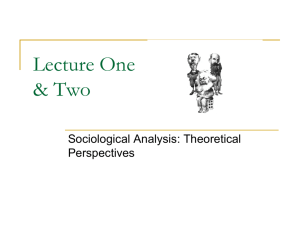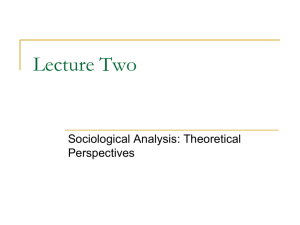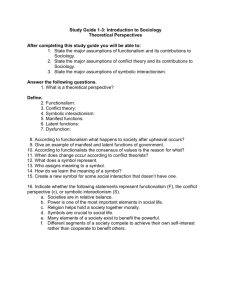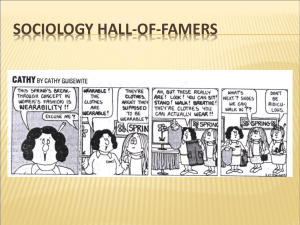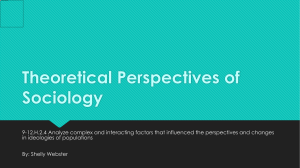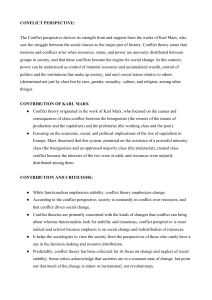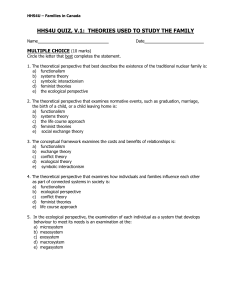Social Sciences Exam: Marxism, Functionalism, Interactionism
advertisement
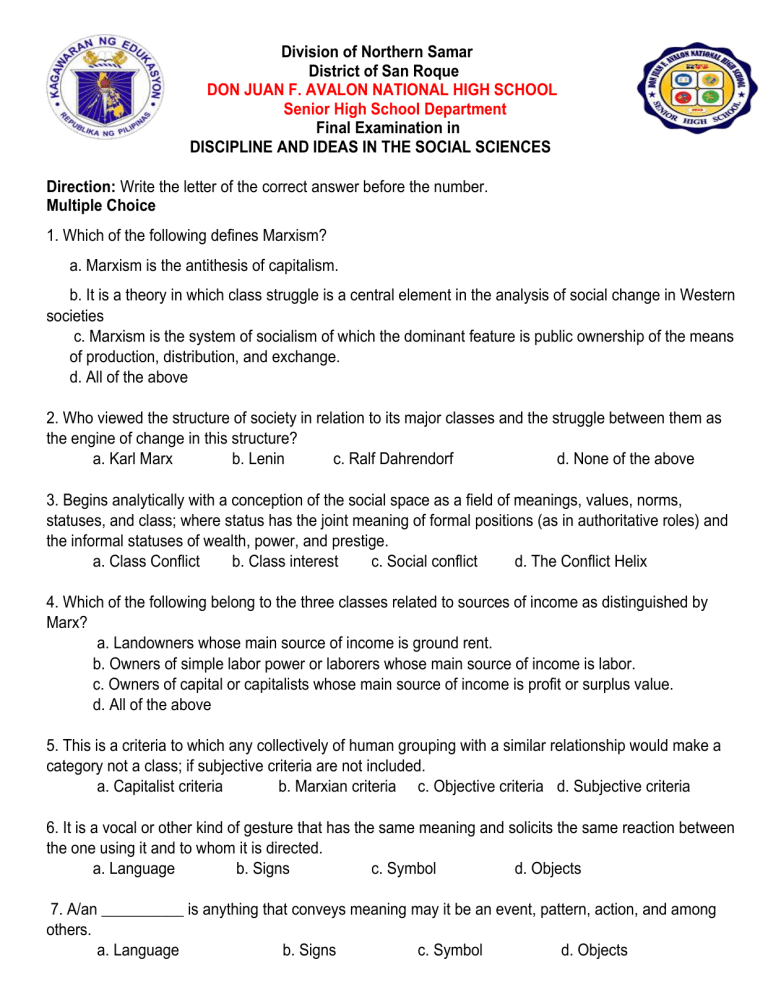
Division of Northern Samar District of San Roque DON JUAN F. AVALON NATIONAL HIGH SCHOOL Senior High School Department Final Examination in DISCIPLINE AND IDEAS IN THE SOCIAL SCIENCES Direction: Write the letter of the correct answer before the number. Multiple Choice 1. Which of the following defines Marxism? a. Marxism is the antithesis of capitalism. b. It is a theory in which class struggle is a central element in the analysis of social change in Western societies c. Marxism is the system of socialism of which the dominant feature is public ownership of the means of production, distribution, and exchange. d. All of the above 2. Who viewed the structure of society in relation to its major classes and the struggle between them as the engine of change in this structure? a. Karl Marx b. Lenin c. Ralf Dahrendorf d. None of the above 3. Begins analytically with a conception of the social space as a field of meanings, values, norms, statuses, and class; where status has the joint meaning of formal positions (as in authoritative roles) and the informal statuses of wealth, power, and prestige. a. Class Conflict b. Class interest c. Social conflict d. The Conflict Helix 4. Which of the following belong to the three classes related to sources of income as distinguished by Marx? a. Landowners whose main source of income is ground rent. b. Owners of simple labor power or laborers whose main source of income is labor. c. Owners of capital or capitalists whose main source of income is profit or surplus value. d. All of the above 5. This is a criteria to which any collectively of human grouping with a similar relationship would make a category not a class; if subjective criteria are not included. a. Capitalist criteria b. Marxian criteria c. Objective criteria d. Subjective criteria 6. It is a vocal or other kind of gesture that has the same meaning and solicits the same reaction between the one using it and to whom it is directed. a. Language b. Signs c. Symbol d. Objects 7. A/an __________ is anything that conveys meaning may it be an event, pattern, action, and among others. a. Language b. Signs c. Symbol d. Objects 8. A __________ sign or symbol is anything associated with some other thing or event, but it is produced and controlled by the very organisms that have learned to respond to it. a. Conventional b. Natural c. Public d. All of the above 9. Which fact belong to the impact of using symbol on human beings. a. Symbols transform the very nature of the environment in which the human species live. b. Symbols make it possible for the individual to be part of the very environment to which he or she responds, thus it makes possible the development of self c. Symbols make it possible for the behavioral dispositions, or attitudes, of one individual to be reproduced in another person. d. All of the above 10. Which of the following DOES NOT belong to the phases of acts? a. Impulse b. Tangible c. Perception d. Manipulation 11. It is a social behavior made up of communication to which individuals react; consequently, causing a change in behavior. a. Interactions b. Roles c. Identity d. Symbols 12. This perspective relies on the symbolic meaning that people develop and rely upon in the process of social interaction. a. Identity b. Symbolic interactionism c. Roles d. None of the above 13. It is a broad perspective in sociology and anthropology which sets out to interpret society as a structure with interrelated parts. a. Functionalism b. Marxism c. Psychoanalysis d. Symbolic Interactionism 14. He is a British philosopher famous for applying the theory of natural selection to society, and was in many ways, the first true sociological functionalist. a. Durkheim b. Herbert Spencer c. Robert Merton d. Talcott Parsons 15. Parsons constructed a set of variables that can be used to analyze the various systems. Which of the following belong to the five pattern variables? a. Ascription and Achievemen b. Affectivity and Affective Neutrality c. Diffuseness and Specificity d. All of the above 16. It is an approach in sociology that views society as a complex system whose parts work together to promote solidarity and stability. a. Marxism b. Structural – Functionalism c. Symbolic Interactionism d. Psychoanalytic 17. He is an American sociologist and functionalist who attempted to develop and perfect a general analytic model suitable for analyzing all types of collectivities. a. Charles Darwin b. Emile Durkheim c. Karl Marx d. Talcott Parson 18. He is the French philosopher who noticed and started to think that society was made up of building blocks that were focused towards a common goal. a.Charles Darwin b.Emile Durkheim c. Karl Marx d. Talcott Parson 19. This occurs when an individual has the means and desire to achieve the cultural goals socialized into him. a. Conformity b. Rebellion c. Retreatism d. Ritualism 20. It occurs when an individual continues to do things as prescribed by society but forfeits the achievement of the goals. a. Conformity b. Rebellion c. Retreatism d. Ritualism 21. It involves the rejection of both the culturally prescribed goals as well as the conventional means of attaining them. a. Conformity b. Rebellion c. Retreatism d. Ritualism 22. A combination of the rejection of societal goals and means and a substitution of other goals and means. a. Conformity b. Rebellion c. Retreatism d. Ritualism 23. It refers to the innate qualities of individuals. a. Achievement Orientation b. Affective Neutrality c. Ascription Orientation d. Diffuseness 24. When role obligations are extended outside the defined role - expectations. a. Achievement Orientation b. Affective Neutrality c. Ascription Orientation Diffuseness d. 25. Places an importance on the performance and emphasizes individual achievement. A. Achievement Orientation B. Ascription Orientation C. Affective Neutrality Diffuseness D. 26. Which perspective is the creation of E. Durkheim? a. Functionalism b. Conflict Theory c. Psychoanalysis d. Symbolic Interactionism 27. The ________ perspective focuses on how individuals act with one another in daily situations. a. Functionalism b. Conflict Theory c. Psychoanalysis d. Symbolic Interactionism 28. Karl Marx proposed that society would be better if all classes would rise up and fight until there was only one class of people. This is ____theory. a. Functionalism b. Conflict Theory c. Psychoanalysis d. Symbolic Interactionism 29. If I define teacher as a responsible individual who wears fuzzy sweaters and drinks coffee all day, and so I behave that way, then that is an example of which sociological theory in practice? a.Functionalism b. Conflict Theory c. Psychoanalysis d. Symbolic Interactionism 30. Which theory says that society is a system of interconnected parts that work together to maintain balance? a. Functionalist Theory b. Conflict Theory c. Symbolic Interactionism d. Psychoanalysis 31. Which of the three theories is the only micro theory (focuses on individual interaction)? a.Functionalism b. Conflict Theory c. Psychoanalysis d. Symbolic Interactionism 32. He believed that all of history could be explained and was driven by class conflict. a. Karl Marx b. Emile Durkheim c. Herbert Spencer d. Max Weber 33. According to Marx, the history of all society up to his time is the history of ____. a. Class Struggles b. Political Problems c. Racism d. Gender 34. Which of the following traits is the characteristic of modern bourgeois society? a. Class relationships have been eradicated. b. All societies believe in communism. c. Exploitative class relationships are no longer hidden. d. None of the above 35. Who had been the big influence to Karl Marx? a. John Stuart Mill b. G.W.F. Hegel c. Aristotle d. Plato 36. One type of communism that exists nowadays is _____________. a. Anarcho-Communism b. Neo-Communism c. Liberal-Communism d. FrenchCommunism 37. This period within classical Marxism comprised the debates conducted during the first decades following Marx’s death. a. The Marxism of the Second International b. The Marxism of the Third International c. Early Socialism d. None of the above 38. Who formulated a three-component theory of social stratification, which included class, status, and party? a. Karl Marx b. Max Weber c. Pierre Bourdieu d. None of the above 39. It happens when there is incompatible expectations attached to some positions in a social relationship. a. Role conflict c. Role taking b. Social structure d. Social act 40. It is the process by which the newcomer becomes incorporated into the organized a. Interactions c. Socialization b. Role taking d. All of the above 41. This refers to the framework for understanding the impact of the unconscious on thoughts, feelings, and behavior. a. Psychoanalytic Theory b. Unconscious c.Conscious d. Id 42. The material that we have no immediate access to, and we cannot bring into consciousness. It includes repressed feelings, hidden memories, habits, thoughts, desires, and reactions. a. Psychoanalytic Theory b. Unconscious c.Conscious d. Id 43. It contains those thoughts of which you are currently aware. a. Psychoanalytic Theory b. Unconscious c.Conscious d. Id 44. It is concerned only with satisfying personal desires. a. Psychoanalytic Theory b. Unconscious d. Id c.Conscious 45. Individuals choose their actions optimally, given their individual preferences as well as the opportunities or constraints with which the individuals face. a. Optimality b.Rationality c. Individualism d. Self-Regarding Interest 46. It is the most predominant assumption of the rational choice theory. a. Optimality b.Rationality c. Individualism d. Self-Regarding Interest 47. It is the ability of individuals to ultimately take actions. a. Optimality b.Rationality c. Individualism d. Self-Regarding Interest 48. This assumption states that the actions of an individual is concerned entirely with his/her own welfare. a. Optimality b.Rationality c. Individualism d. Self-Regarding Interest 49. Bids the psychic apparatus to pursue idealistic goals and perfection. a. Optimality b.Rationality c. Superego d. Structure 50. These structures and norms that dictate a single course of action are merely special cases of rational choice theory. a. Optimality b.Rationality c. Superego d. Structure Prepared by: HERMILIE R. POCHE, LPT Subject Teacher Noted by: NOEL M. LAGRIMAS,MAED OIC, SHS-Principal
